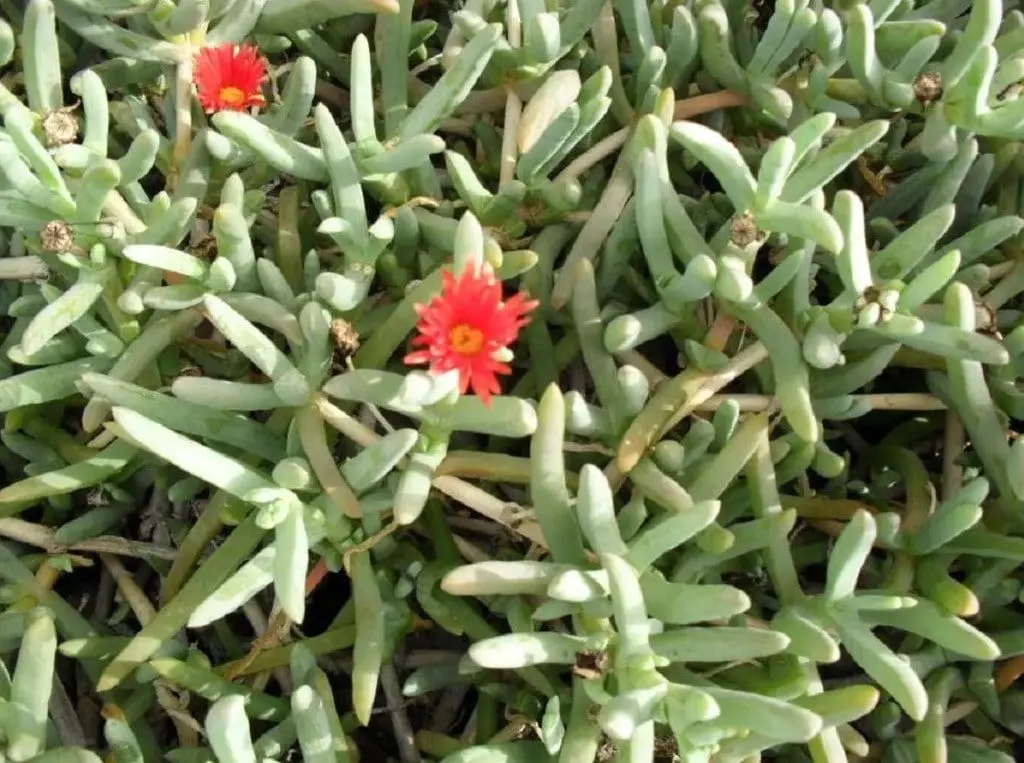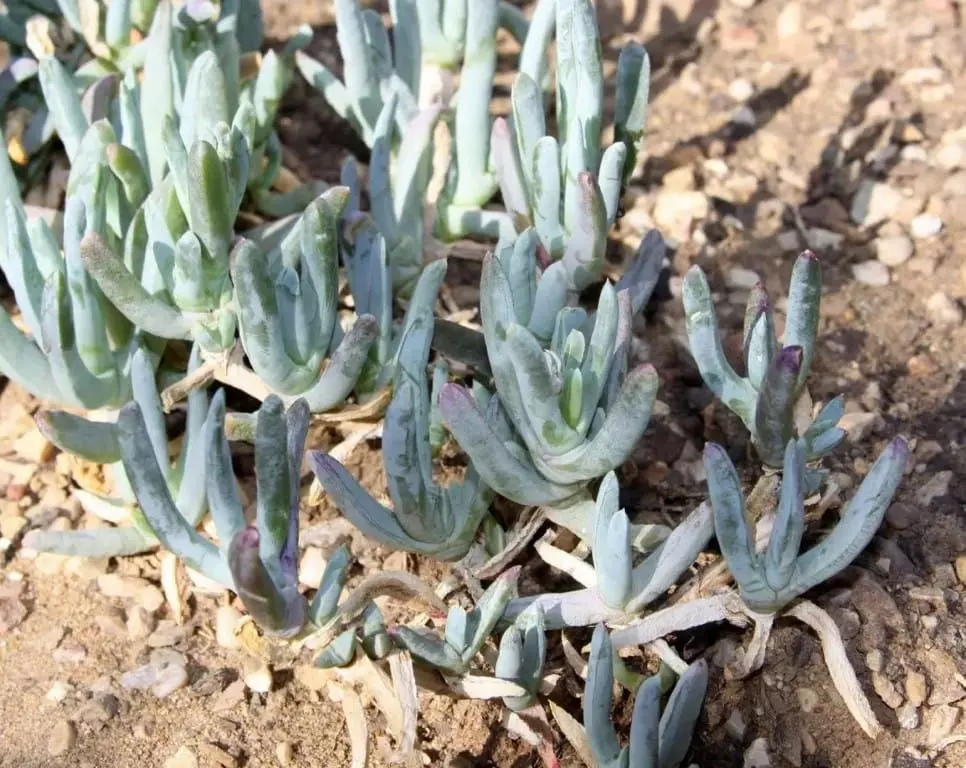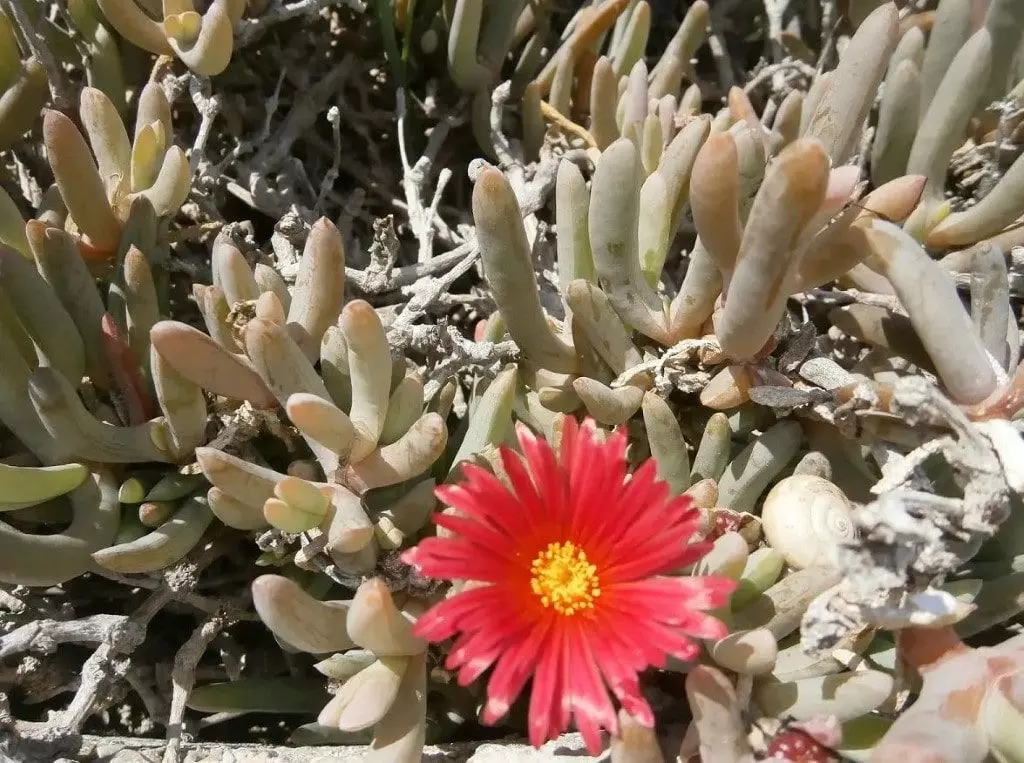Today we are going to talk about a type of plant that belongs to the succulent plant group and the Aizoaceae family. It is the Malephora crocea succulent plant, also known as Croceum Iceplant. We are going to dedicate this article to talking about Malephora crocea care, its characteristics as a succulent plant, and Malephora crocea propagation.
Table of Contents
Malephora crocea Main Characteristics
The term malephora comes from the Greek language “Maleo” meaning “charm” and “Pherein” meaning “to carry”. It refers to the fact that Malephora crocea has a charm that makes it be used for ornamentation.
It is a plant that belongs to the succulent group so it has some similar characteristics to the rest of its group. Malephora crocea plants are evergreen and have a creeping habit. Due to their constitution, they cannot be stepped on. They are quite small in size, barely exceeding 8″- 12″ (20-30 centimeters).
This plant is evergreen and has a creeping habit. It cannot be walked on and is not edible by humans. They are quite small in size and have some special characteristics.
It has fleshy and tubular leaves of a grayish-green or bluish color. The beautiful thing about this species is the flowers. It produces small, but abundant and showy flowers. The flowering takes place from the first part of spring until late summer. They are very numerous and have bright colors. All the flowers can be of different very showy colors among which are yellow, orange, pink, reddish, and fuchsia.
Malephora crocea flowers usually appear isolated and do not form any clusters. They can appear from the first year of the life of the plant, so it is a perfect plant for ornamentation. Other plants take longer to make their flowers can grow. This would be one of the fastest plants to make flowers and bloom if we want to have a showy garden in a short time.
The flowers open completely during the core hours of the day during the moments of greater insolation and direct sun. Unlike other species that do not tolerate direct sunlight, Malephora crocea loves it.
Malephora crocea flowers (also known as Croceum Iceplant) should not be confused with Carpobrotus edulis (also known as sour fig plant, ice plant, highway ice plant), which is also a succulent plant.
Malephora crocea flower opens when the day is bright and sunny, and for this reason, many people confuse Malephora crocea flowers with Carpobrotus edulis.
Malephora crocea pollination is carried out by flies, bees, wasps, and other insects that are attracted by the nectar produced by the flower. Therefore, you should know that if you introduce this plant to your garden you will attract beneficial insects to it.
When Malephora crocea grows it forms a long-blooming ground cover. This plant is considered an invasive plant because of its ease of growth, and spread. Also, Malephora crocea has been shown to be resistant to fire, heat and drought, and can adapt very well to different types of soils and climates such as coastal climates, with high tolerance to a wide variety of soil conditions, such as coastal soils with high salt content. So, our recommendation is to keep Malephora crocea in pots, where it will be easier to control its growth and propagation.
Malephora crocea growing in the soil vegetatively invades adjacent areas precisely because of this characteristic that we mentioned that it is a creeping type plant. The problem with Malephora crocea as an invasive plant is that in nature parts of the plant break off (stems, leaves) and move through storm drains to establish themselves in wet areas downstream. And surely you know how easy is to propagate succulent plants and spread them easily.
Therefore, cities like Dana Point, in California identify invasive plants such as Malephora crocea, most of which are ornamental plants introduced to the environment, are of highest concern, encouraging discontinue their use and eradication. Scientific studies have shown that it is vital to prevent new plant invasions in order to reduce large-scale ecological change. The majority of research has been on the purposeful introduction of nonnatives through the decorative plant trade. Accidental introduction, on the other hand, may be a significant source of nonnative, invasive species.
Malephora crocea should not be eaten by humans.

Care of Malephora crocea
Malephora crocea Care. Let’s see some of the care and tips we can give you about this succulent plant.
Malephora crocea Care. As we have already seen in the rest of the article, it needs prolonged sun exposure to achieve good flowering. It can resist some sporadic frost but of very low intensity. Temperatures should not fall below 23°F (-5°C). It has a fairly rapid growth and its flowers thrive during the first year.
Malephora crocea Care. They can grow in almost any type of soil, as long as it is well-drained and does not accumulate rain or irrigation water. Thanks to their adaptability they grow in poor, sandy soils. They are very resistant to drought and have mechanisms for water retention. Therefore, watering should be very moderate. A small amount of water is sufficient if the summer is too dry and hot. If the plant suffers an extreme drought, it will not indicate it by turning its leaves reddish.
Malephora crocea Care. Although it is not necessary, it can be fertilized at the end of winter with some well-decomposed compost or homemade compost.
Malephora crocea Care. Among the maintenance tasks, you can always prune when the flowers are faded and leave room to improve the next flowering.
The biggest risk for this plant, as well as for succulent plants, is overwatering, as they are resistant to garden pests and diseases.
Leaves and Seeds of Malephora crocea
Malephora crocea Leaves and Seeds, The leaves are elongated, smooth, and have “no hairs”. We know that many plants of the succulent group have small hairs that serve to protect themselves from temperature changes and retain moisture.
Malephora crocea leaves have a triangular section rather rounded and opposite. Its peduncle is quite short and has a smooth edge. The leaves are soft, not thorny or leathery. The color is always green and clear or grayish-green. They can become glaucous and turn a more reddish color if they suffer from a lack of water. It must be taken into account that these plants are typical of desert areas, so they are completely adapted to drought.
Malephora crocea seeds are quite numerous and can appear in quantities of 75 units per flower. They are lenticular seeds of small size and rough surface. Some of them remain in the base of the flower capsule for a later occasion. This quantity of seeds makes the plant very successful in reproducing and expanding its distribution area, explaining why can be so invasive.
Malephora crocea Propagation
Malephora crocea propagation. Like many other succulent plants, Malephora crocea can be easily propagated by cuttings and by seeds.

Distribution Area and Uses
Malephora crocea grows naturally at an altitude of 3600 to 5250 ft (1100 to 1600 meters). Normally its natural habitat is the Karoo Desert in South Africa and Namibia. It is endemic to these places, although it can adapt perfectly well to other warm, dry, and frost-free areas. Thanks to this it is a plant that has spread throughout the world with fully ornamental uses.
Specimens can be found in California, Australia, Spain, Mexico, Arizona, and Malta, among others. It is also worth mentioning that they have been able to adapt to coastal areas, becoming invasive in some Mediterranean climates and becoming completely naturalized in California since the 1940s.
All this says a lot about a succulent capable of adapting to extreme drought conditions and, although it is an endemic species, its distribution area is almost worldwide. It belongs to the Aizoaceae family and is made up of about 15 species, all of which are succulents from southern Africa. Among the common names it has, the coppery Mesen stands out.
As for the uses of the Malephora crocea, we see that they can be used in rockeries and for borders being more suitable for pots and planters. It can grow perfectly if we place it in terraces and balconies since they only need a great amount of light during the day. If the location of the terrace or balcony is very luminous and can take advantage of the hours of greater solar radiation, it will not need much more to develop. They are also ideal plants for gardens that are located by the sea in Mediterranean climates as they tolerate wind and salinity very well.
I hope that with this information you can learn more about Malephora crocea Care, Propagation and Malephora crocea Invasive Plant.

